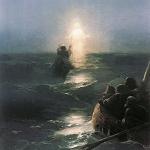1889 is the crossroads where the descendants, living persons and ancestors of previous, current and future influencers meet on the chronological timeline of earth’s history.
We don’t have recordings of people singing for much of the centuries the earth has traveled around the sun. Sure we have plenty of writings for people to read, but their was the problem of translations of books, illiteracy, and rare copies of works. Making a book was not always easy to do and cost alot to make and keep. The printing press changed all that and by the time the 1800’s rolled around more books were being circulated and read. But one medium seems to have endured through the years. You didn’t know how to read to access it. You didn’t need a choir to teach you a tune to remember. All you to do was just look.
Since early times art has captured a moment in time with the talents of the artist. The renaissance was a peak time for paintings and sculptures. The 19th century left us plenty of its history for us to look at in the form of art and the new phenomenon of photography. Some of the classic art we hang on our walls today comes from those alive in 1889. Much of it captures the Life of Christ bringing the gospel to life. It also depicts great scenes and life from American history and life around the globe.
For writers and collectors most of these paintings and photos are in the public domain for you to use at will. Take a look and browse and learn a little about the people who created these works of art.
Please Note
Wikipedia in which the Catholic Bard quotes directly for all the bio descriptions read in these articles.
This article is part of a series of Notable People Alive In 1889
And now….
Born in 1800’s
Eugène Louis Lami
(January 12, 1800 – December 19, 1890)
He was a French painter and lithographer. He was a painter of fashionable Paris during the period of the July Monarchy and the Second French Empire and also made history paintings and illustrations for books such as Gil Blas and Manon Lescaut.

Fedor Solntsev
(April 16, 1801 – 15, 1892)
He was a Russian painter and historian of art. His artwork was a major contribution in recording and preserving medieval Russian culture, which was a common subject of his paintings. He was the main author of the fundamental work Antiquities of the Russian State the main decorator of interiors of the Grand Kremlin Palace in Moscow. He discovered and restored mosaics and frescoes of Saint Sophia Cathedral, Kyiv and Cathedral of the Dormition of Kyiv Pechersk Lavra in Kyiv, and of Cathedral of Saint Demetrius in Vladimir.
Fedor Solntsev, together with Metropolitan Philaret and Archimandrite Photius are considered the founders of modern Russian icon painting canon synthesizing ancient Russian traditions, post-Petrine efforts and modern art discoveries.
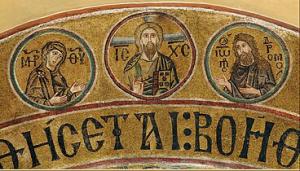
William F. Woodington
(February 10, 1806 – December 24, 1893)
He was an English painter and sculptor. One of his notable works is A bronze plaque on the pedestal of Nelson’s Column in Trafalgar Square depicting Nelson’s loss of an eye at the Battle of the Nile (1838).
Nelson’s Column is a monument in Trafalgar Square in the City of Westminster, Central London, built to commemorate Vice-Admiral Horatio Nelson‘s decisive victory at the Battle of Trafalgar over the combined French and Spanish navies, during which he was killed by a French sniper. The monument was constructed between 1840 and 1843 to a design by William Railton at a cost of £47,000 (equivalent to £5,828,216 in 2023). It is a column of the Corinthian order built from Dartmoor granite. The statue of Nelson was carved from Craigleith sandstone by sculptor Edward Hodges Baily. The four bronze lions around its base were added in 1867 and were designed by
Sir Edwin Landseer
(March 7, 1802 – October 1, 1873)
He was an English painter and sculptor, well known for his paintings of animals – particularly horses, dogs, and stags. He was the son of the engraver John Landseer A.R.A. and Jane Potts. His syblings Thomas, Charles and Jessica, became notable in the art world.
The Monarch of the Glen is an oil-on-canvas painting of a red deer stag completed in 1851 It was commissioned as part of a series of three panels to hang in the Palace of Westminster, in London. As one of the most popular paintings throughout the 19th century, it sold widely in reproductions in steel engraving, and was finally bought by companies to use in advertising. The painting had become something of a cliché by the mid-20th century, as “the ultimate biscuit tin image of Scotland: a bulky stag set against the violet hills and watery skies of an isolated wilderness”, according to the Sunday Herald.
In 2017 the National Galleries of Scotland in Edinburgh launched a successful campaign to buy the painting for £4 million, finally achieving the acquisition. The painting is now part of the collection, and is on display at the Scottish National Gallery.

Robert Cornelius
March 1, 1809 – August 10, 1893)
was an American photographer and pioneer in the history of photography. His daguerreotype self-portrait taken in 1839 is generally accepted as the first known photographic portrait of a person taken in the United States, and a very important achievement for self-portraiture. He operated some of the earliest photography studios in the United States between 1840 and 1842 and implemented innovative techniques to significantly reduce the exposure time required for portraits. He was an inventor, businessman and lamp manufacturer. He created and patented the “solar lamp” in 1843 which burned brighter and allowed for the use of cheaper lard as a fuel source rather than more expensive whale oil.

Born in 1810’s
John Rogers Herbert RA
(January 23, 1810 – March 17, 1890)
He was an English painter who is most notable as a precursor of Pre-Raphaelitism.

Savioursubject – John Rogers Herbert
Our Saviour Subject to his Parents at Nazareth (1847).
Oil on canvas.
John Callcott Horsley RA
(January 29, 1817 – October 18, 1903)
He was a British academic painter of genre and historical scenes, illustrator, and designer of the first Christmas card. He was a member of the artist’s colony in Cranbrook.

The world’s first Christmas card
John Callcott Horsley
Ivan Aivazovsky
(July 29, 1817 – May 2, 1900)
He was a Russian Romantic painter who is considered one of the greatest masters of marine art. Baptized as Hovhannes Aivazian, he was born into an Armenian family in the Black Sea port of Feodosia in Crimea and was mostly based there.

Jesus walking on water (1890) Po vodam – Ivan Aivazovsky
Angelus Painter’s Wife
Jean-François Millet
(October 4, 1814 – January 20, 1875)

He was a French artist and one of the founders of the Barbizon school in rural France. Millet is noted for his paintings of peasant farmers and can be categorized as part of the Realism art movement. Toward the end of his career, he became increasingly interested in painting pure landscapes. He is known best for his oil paintings but is also noted for his pastels, Conté crayon drawings, and etchings.
One of his most famous paintings is the oil painting The Angelus completed between 1857 and 1859.
The painting depicts two peasants bowing in a field over a basket of potatoes to say a prayer, the Angelus, that together with the ringing of the bell from the church on the horizon marks the end of a day’s work. But Louvre made an X-ray of the painting on request of Dali who was impressed greatly by the contrast between the idyllic background and tragic poses of the peasants. It appeared that originally instead of basket with potatoes Millet depicted a baby coffin. Thus the couple was burying their child.
Millet was commissioned by the American would-be painter and art collector Thomas Gold Appleton (March 31, 1812 – April 17, 1884), who never came to collect it. The painting is famous today for driving the prices for artworks of the Barbizon school up to record amounts in the late 19th century.

In 1845, Millet moved to Le Havre with
Catherine-Marie-Josèphe Lemaire
(abt.1818-1894)
whom he married in a civil ceremony in 1853; they had nine children and remained together for the rest of Millet’s life. On January 3, 1875, he married Catherine in a religious ceremony. Millet died on January 20, 1875.
Johan Jongkind
(June 3, 1819 – February 9, 1891)
He was a Dutch painter and printmaker. He painted marine landscapes in a free manner and is regarded as a forerunner of Impressionism.
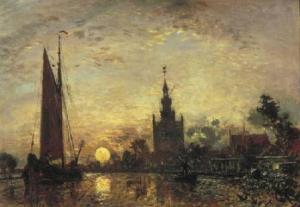
Born in 1820’s
Ford Madox Brown
(April 16, 1821 – October 6, 1893)
He was a British painter of moral and historical subjects, notable for his distinctively graphic and often Hogarthian version of the Pre-Raphaelite style. Arguably, his most notable painting was Work (1852–1865). Brown spent the latter years of his life painting the twelve works known as The Manchester Murals, depicting Mancunian history, for Manchester Town Hall.

Antonio Ciseri
(October 25, 1821 – March 8, 1891) was a Swiss-Italian painter of religious subjects.
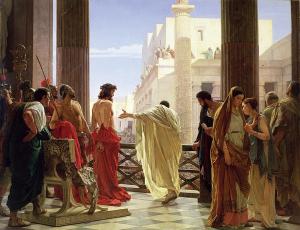
Ecce homo (1871) by Antonio Ciseri
Mathew Brady
(c. 1822–1824 – January 15, 1896)
He was an American photographer. Known as one of the earliest and most famous photographers in American history, he is best known for his scenes of the Civil War. He studied under inventor Samuel Morse, who pioneered the daguerreotype technique in America. Brady opened his own studio in New York City in 1844, and went on to photograph U.S. presidents John Quincy Adams, Abraham Lincoln, Millard Fillmore, Martin Van Buren, and other public figures.
When the Civil War began, Brady’s use of a mobile studio and darkroom enabled thousands of vivid battlefield photographs to bring home the reality of war to the public. He also photographed generals and politicians on both sides of the conflict, though most of these were taken by his assistants rather than by Brady himself.
After the end of the Civil War, these pictures went out of fashion, and the government did not purchase the master copies as he had anticipated. Brady’s fortunes declined sharply, and he died in debt.

Domenico Morelli
(August 4, 1823 – August 13, 1901)
He was an Italian painter, who mainly produced historical and religious works.

Christ watches over the Apostles (1891)
Johannes Adam Simon Oertel
(November 3, 1823 – December 9, 1909)
He was a German-American Episcopal clergyman and artist.

Rock of ages (1876) | ColourThySoul (tumblr.com)
Heinrich Hofmann
(March 19, 1824 – June 23, 1911)

Christ And The Rich Young Ruler (1889)
He was a German painter of the late 19th to early 20th century. He was the uncle of the German painter Ludwig von Hofmann. He was born in Darmstadt and died in Dresden. He is best known for his many paintings depicting the life of Jesus Christ.

Christ in Gethsemane (1890)
(May 11, 1824 – January 10, 1904)

Eliza Allen Starr
(August 29, 1824 – September 8, 1901)

She was an American artist, art critic, teacher, and lecturer. She was known throughout the United States and Europe for her books about Catholic art.

William-Adolphe Bouguereau
(November 30, 1825 – August 19, 1905)
He was a French academic painter. In his realistic genre paintings, he used mythological themes, making modern interpretations of classical subjects, with an emphasis on the female human body.
Song of the Angels, which debuted at the Paris Salon in 1881, was once a part of the Wanamaker Collection in Philadelphia.
Legend has it that he searched for a model for the painting’s figures and found them in his first wife, Nelly Monochablon, who posed for the angels, one by one, and at last, with a child in her arms. The painting shows the Virgin Mary holding the baby Jesus Christ, who is calmly asleep in a pastoral setting, while a trio of angels hovers nearby. It highlights Bouguereau’s ability to render realistic flesh tones and subtle gradations of white.
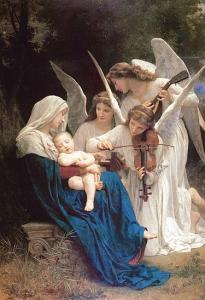
Bernhard Plockhorst
(March 2, 1825 – May 18, 1907)

He was a German painter and graphic artist. In Germany, Plockhorst is mainly known to experts today, whereas his pictures are still very popular in the United States and their reproductions can be found in many American homes and churches.

William Holman Hunt
(April 2, 1827 – September 7, 1910)

He was an English painter and one of the founders of the Pre-Raphaelite Brotherhood. His paintings were notable for their great attention to detail, vivid colour, and elaborate symbolism.
The Light of the World (1851–1854) is an allegorical painting representing the figure of Jesus preparing to knock on an overgrown and long-unopened door, illustrating Revelation 3:20: “Behold, I stand at the door and knock; if any man hear My voice, and open the door, I will come in to him, and will sup with him, and he with Me”. According to Hunt: “I painted the picture with what I thought, unworthy though I was, to be divine command, and not simply a good subject.” The door in the painting has no handle, and can therefore be opened only from the inside, representing “the obstinately shut mind”. The painting was considered by many to be the most important and culturally influential rendering of Christ of its time.

Jules Breton
(May 1, 1827 – July 5, 1906)
He was a 19th-century French naturalist painter. His paintings are heavily influenced by the French countryside and his absorption of traditional methods of painting helped make him one of the primary transmitters of the beauty and idyllic vision of rural existence.
In February 2014, actor Bill Murray said at a press event for the film, The Monuments Men, that a chance encounter with Brenton’s The Song of the Lark at the Art Institute of Chicago helped him in his early career when he was contemplating suicide.
With Advent approaching, you might consider this a kind of visual lectio for the season ahead. – Deacon Greg Kandra

Sir John Everett Millais, 1st Baronet
(June 8, 1829 – 13 August 1896)
He was an English painter and illustrator who was one of the founders of the Pre-Raphaelite Brotherhood. He was a child prodigy who, aged eleven, became the youngest student to enter the Royal Academy Schools. The Pre-Raphaelite Brotherhood was founded at his family home in London, at 83 Gower Street (now number 7). Millais became the most famous exponent of the style, his painting Christ in the House of His Parents (1849–50) generating considerable controversy, and he produced a picture that could serve as the embodiment of the historical and naturalist focus of the group, Ophelia, in 1851–52.

Edward Moran
(August 19, 1829 – June 8, 1901)
He was an English-born American painter who specialized in marine art. He is best known for his series of thirteen paintings on the maritime history of the United States.
Unveiling of the Statue of Liberty Enlightening the World (1886) by Edward Moran. Oil on canvas. The J. Clarence Davies Collection, Museum of the City of New York.

Born in 1830’s
Ary Scheffer’s Daughter
Ary Scheffer
(February 10, 1795 – 15 June 1858)
He was a Dutch-French Romantic painter. He was known mostly for his works based on literature, with paintings based on the works of Dante, Goethe, Lord Byron and Walter Scott, as well as religious subjects. He was also a prolific painter of portraits of famous and influential people in his lifetime. Politically, Scheffer had strong ties to King Louis Philippe I, having been employed as a teacher of the latter’s children, which allowed him to live a life of luxury for many years until the French Revolution of 1848.

The Temptation of Christ (1854)
Scheffer is the father of
Cornélia Scheffer
(July 29, 1830 – December 20, 1899)
She was a French artist and designer, notable for her drawings, ceramics and sculptures.early 20th century. He was the uncle of the German painter Ludwig von Hofmann. He was born in Darmstadt and died in Dresden. He is best known for his many paintings depicting the life of Jesus Christ.
Eadweard Muybridge
(April 9, 1830 – May 8, 1904,
He was an English photographer known for his pioneering work in photographic studies of motion, and early work in motion-picture projection.

Valley of Tears Painters Brother
Gustave Doré
(January 6, 1832 – January 23, 1883)
He was a French printmaker, illustrator, painter, comics artist, caricaturist, and sculptor. He is best known for his prolific output of wood-engravings illustrating classic literature, especially those for the Vulgate Bible and Dante’s Divine Comedy.
He is the Brother of Paul Emilé Doré (1834-1903)

The Valley of Tears (1883)
Sir Edward Coley Burne-Jones, 1st Baronet
28 August 1833 – 17 June 1898)
He was an English painter and designer associated with the Pre-Raphaelite Brotherhood‘s style and subject matter.

Carl Bloch
(May 23, 1834 – February 22, 1890)

He was a Danish artist has oodles of paintings of the life of Christ.
For over 40 years, The Church of Jesus Christ of Latter-day Saints has made heavy use of Bloch’s paintings, mostly from the Frederiksborg Palace collection, in its church buildings and printed media. The church has produced films depicting scriptural accounts of Christ’s public ministry, using Bloch’s paintings as models for the colour, light and overall set design, as well as the movement of the actors in many of the films’ scenes. The most notable example of this is the 2000 film The Testaments of One Fold and One Shepherd.
Edgar Degas
(July 19, 1834 – September 27, 1917)
He was a French Impressionist artist famous for his pastel drawings and oil paintings.

The Ballet Class (Degas, Musée d’Orsay)
James McNeill Whistler
(July 10, 1834 – July 17, 1903)
He was an American painter in oils and watercolor, and printmaker, active during the American Gilded Age and based primarily in the United Kingdom. He eschewed sentimentality and moral allusion in painting and was a leading proponent of the credo “art for art’s sake“.
By 1871, Whistler produced his most famous painting, the nearly monochromatic full-length figure entitled Arrangement in Grey and Black No.1, but usually referred to as Whistler’s Mother. A model failed to appear one day, according to a letter from his mother, so Whistler turned to his mother and suggested that he do her portrait. He had her stand at first, in his typically slow and experimental way, but that proved too tiring so the seated pose was adopted. It took dozens of sittings to complete.
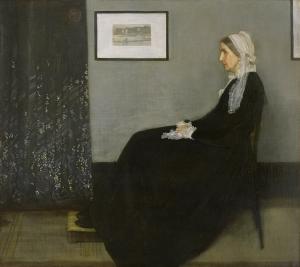
Frédéric Auguste Bartholdi
August 2, 1834 – October 4, 1904)

He was a French sculptor and painter. He is best known for designing Liberty Enlightening the World, commonly known as the Statue of Liberty.

William McTaggart
(October 25, 1835 – April 2, 1910)
He was a Scottish landscape and marine painter who was influenced by Impressionism.
Spring by William McTaggart (1864)
Pere Borrell del Caso
(December 13, 1835 – May 16, 1910)
He was a Catalan Spanish painter, illustrator and engraver, known for his trompe-l’œil paintings; especially Escaping Criticism (1874).

Lawrence Alma-Tadema
(January 8, 1836 – June 25, 1912)
He was a Dutch painter who later settled in the United Kingdom, becoming the last officially recognised denizen in 1873. Born in Dronryp, the Netherlands, and trained at the Royal Academy of Antwerp, Belgium, he settled in London, England in 1870 and spent the rest of his life there.

The Inundation of The Biesbosch in 1421 (1856)
St. Elizabeth’s flood (1421)
Winslow Homer
(February 24, 1836 – September 29, 1910)

He was an American landscape painter and illustrator, best known for his marine subjects. He is considered one of the foremost painters of 19th-century America and a preeminent figure in American art in general.

Emmanuel Benner
(March 28, 1836 – September 23,1896)
He was a French Academic painter and draughtsman. The son of the painter Jean Benner-Fries (1796–1849), he was twin to fellow artist, Jean Benner (March 28, 1836 – October 28, 1906) and the uncle of the painter Emmanuel Michel Benner (July 17, 1873 – November 12, 1965, Jean’s son. Like his twin brother, he was portrayed by fellow Alsatian, Jean-Jacques Henner (March 5, 1829 – July 23, 1905).

Archibald Willard
(August 22, 1836 – October 11, 1918)

He was an American painter who was born and raised in Bedford, Ohio. He was the son of Samuel Willard, the pastor of Bedford Baptist Church.

Lot Flannery
(1836–December 19, 1922)
He was an Irish-American sculptor from Washington, D.C., best known for his work in 1868 on the Abraham Lincoln statue located outside the District of Columbia City Hall and the nation’s oldest extant memorial to the assassinated president.

James Tissot
(October 15, 1836 – August 8, 1902)
He was a French painter, illustrator, and caricaturist.

What Our Lord Saw from the Cross
Charles Sedelmeyer
(April 30, 1837 – August 9, 1925)
He was an Austrian and French art dealer, collector, and publisher active in Paris from 1866, with premises at 6 rue de la Rochefoucauld.
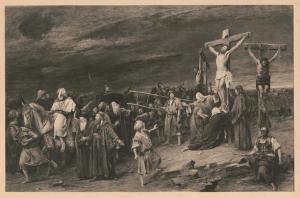
John Thomson (photographer)
(June 14, 1837 – September 29, 1921)
He was a pioneering Scottish photographer, geographer, and traveller. He was one of the first photographers to travel to the Far East, documenting the people, landscapes and artefacts of eastern cultures. Upon returning home, his work among the street people of London cemented his reputation, and is regarded as a classic instance of social documentary which laid the foundations for photojournalism. He went on to become a portrait photographer of high society in Mayfair, gaining the royal warrant in 1881.

Jan Matejko
(June 24, 1838 – November 1, 1893)
He was a Polish painter, a leading 19th-century exponent of history painting, known for depicting nodal events from Polish history. His works include large scale oil paintings such as Stańczyk (1862), Rejtan (1866), Union of Lublin (1869), Astronomer Copernicus, or Conversations with God (1873), or Battle of Grunwald (1878). He was the author of numerous portraits, a gallery of Polish monarchs in book form, and murals in St. Mary’s Basilica, Kraków. He is considered by many as the most celebrated Polish painter, and sometimes as the “national painter” of Poland.

Stańczyk (1862), was acquired by the Warsaw National Museum in 1924. During World War II it was looted by the Nazis, but later seized by the Soviet Union and returned to Poland around 1956.
(15 March 1839 – 9 March 1924)
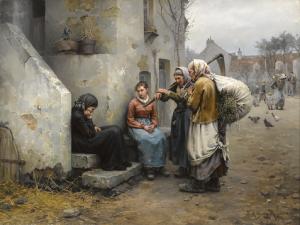
Born in 1840’s
Auguste Rodin
(November 12, 1840 – November 17, 1917)
was a French sculptor generally considered the founder of modern sculpture. He was schooled traditionally and took a craftsman-like approach to his work. Rodin possessed a unique ability to model a complex, turbulent, and deeply pocketed surface in clay. He is known for such sculptures as The Thinker, Monument to Balzac, The Kiss, The Burghers of Calais, and The Gates of Hell.

Claude Monet
(November 1840 – 5 December 1926)
He was a French painter and founder of impressionism painting who is seen as a key precursor to modernism, especially in his attempts to paint nature as he perceived it. During his long career, he was the most consistent and prolific practitioner of impressionism’s philosophy of expressing one’s perceptions of nature, especially as applied to plein air (outdoor) landscape painting. The term “impressionism” is derived from the title of his painting Impression, soleil levant, which was first exhibited in the so-called “exhibition of rejects” of 1874–an exhibition initiated by Monet and like-minded artists as an alternative to the Salon
His Woman with a Parasol – Madame Monet and Her Son, sometimes known as The Stroll from 1875 is Impressionist work depicts his wife Camille Monet and their son Jean Monet in the period from 1871 to 1877 while they were living in Argenteuil, capturing a moment on a stroll on a windy summer’s day.

Pierre-Auguste Renoir
(February 25, 1841 –December 3, 1919)
He was a French artist who was a leading painter in the development of the Impressionist style. As a celebrator of beauty and especially feminine sensuality, it has been said that “Renoir is the final representative of a tradition which runs directly from Rubens to Watteau.”
In 1890, he married Aline Victorine Charigot, a dressmaker twenty years his junior, who, along with a number of the artist’s friends, had already served as a model for Le Déjeuner des canotiers (Luncheon of the Boating Party; she is the woman on the left playing with the dog) in 1881, and with whom he had already had a child, Pierre, in 1885. After marrying, Renoir painted many scenes of his wife and daily family life including their children and their nurse, Aline’s cousin Gabrielle Renard. The Renoirs had three sons: Pierre Renoir (1885–1952), who became a stage and film actor; Jean Renoir (1894–1979), who became a filmmaker of note; and Claude Renoir (1901–1969), who became a ceramic artist. He was the grandfather of the filmmaker Claude Renoir (1913–1993), son of Pierre.
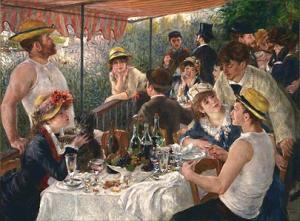
Robert Bateman
(1842–1922)
He was a British painter, architect and horticultural designer.

The Pool of Bethesda (1877)
William Henry Jackson
(April 4, 1843 – June 30, 1942)
He was an American photographer, Civil War veteran, painter, and an explorer famous for his images of the American West. He was a great-great nephew of Samuel Wilson, the progenitor of America’s national symbol Uncle Sam. He was the great-grandfather of cartoonist Bill Griffith, creator of Zippy the Pinhead comics.

Augustus Edwin Mulready
(February 23, 1844 – March 15, 1904)
He was an English genre painter whose work often depicted London street scenes with urchins and flower-sellers.

Wandering Minstrels (1876)
21 May 21, 1844 – 2 September 2, 1910) was a French post-impressionist painter in the Naïve or Primitive manner. He was also known as Le Douanier (the customs officer), a humorous description of his occupation as a toll and tax collector. He started painting seriously in his early forties; by age 49, he retired from his job to work on his art full-time.
Ridiculed during his lifetime by critics, he came to be recognized as a self-taught genius whose works are of high artistic quality. Rousseau’s work exerted an extensive influence on several generations of avant-garde artists.
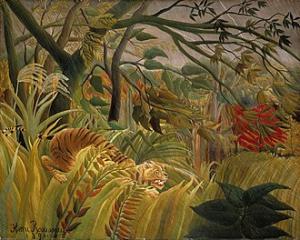
Mary Cassatt
(May 22, 1844 – June 14, 1926)
She was an American painter and printmaker. She was born in Allegheny, Pennsylvania (now part of Pittsburgh‘s North Side), and lived much of her adult life in France, where she befriended Edgar Degas and exhibited with the Impressionists. Cassatt often created images of the social and private lives of women, with particular emphasis on the intimate bonds between mothers and children.
She was described by Gustave Geffroy as one of “les trois grandes dames” (the three great ladies) of Impressionism alongside Marie Bracquemond and Berthe Morisot. In 1879, Diego Martelli compared her to Degas, as they both sought to depict movement, light, and design in the most modern sense.

Gustaf Olof Cederström
(1845-1933)
He was a Swedish painter who specialized in historical scenes and portraits.


Luc-Olivier Merson
(May 21, 1846 – November 13, 1920)
He was a French academic painter and illustrator also known for his postage stamp and currency designs.

Rest on the Flight into Egypt (1879; Museum of Fine Arts, Boston).
Emanuel Leutze’s Children
Emanuel Leutze
(May 24, 1816 – July 18, 1868)
He was a German-born American history painter best known for his 1851 painting Washington Crossing the Delaware. He is associated with the Düsseldorf school of painting.

Ida Maria Leutze Wheeler
1846–1908
Adm Eugene Henry Cozzens Leutze
1847–1931
Eduard von Grützner
(May 26, 1846 – April 2, 1925)
He was a German painter and professor of art. He was especially noted for his genre paintings of monks. He also repeatedly portrayed Falstaff.

Raja Ravi Varma
(April 29, 1848 – October 2, 1906)

He was an Indian painter and artist. His works are one of the best examples of the fusion of European academic art with a purely Indian sensibility and iconography. Especially, he was notable for making affordable lithographs of his paintings available to the public, which greatly enhanced his reach and influence as a painter and public figure. His lithographs increased the involvement of common people with fine arts and defined artistic tastes among the common people. Furthermore, his religious depictions of Hindu deities and works from Indian epic poetry and Puranas have received profound acclaim. He was part of the royal family of erstwhile Parappanad, Malappuram district.

John William Waterhouse RA
(baptised April 6, 1849 – February 10, 1917)

Waterhouse-sleep and his half-brother death (1874)
He was an English painter known for working first in the Academic style and for then embracing the Pre-Raphaelite Brotherhood‘s style and subject matter. His paintings are known for their depictions of women from both ancient Greek mythology and Arthurian legend. A high proportion depict a single young and beautiful woman in a historical costume and setting, though there are some ventures into Orientalist painting and genre painting, still mostly featuring women.

The Lady of Shalott (1888)
C. S. Fly
(May 2, 1849 – October 12, 1901)
He was an Old West photographer who is regarded by some as an early photojournalist and who captured the only known images of Native Americans while they were still at war with the United States. He took many other pictures of life in the silver-mining boom town of Tombstone, Arizona, and the surrounding region. He recognized the value of his photographs to illustrate periodicals of the day and took his camera to the scenes of important events where he recorded them and resold pictures to editors nationwide.
He was an eyewitness on October 26, 1881, to the Gunfight at the O.K. Corral, which took place outside his photography studio. He took pictures of a number of Tombstone residents including Tombstone founder Ed Schieffelin, pioneer surgeon Dr. George E. Goodfellow, and others.
He served as Cochise County Sheriff from 1895 to 1897. Most of his negatives were destroyed by two fires that burned his studio to the ground. His widow, photographer Mary E. “Mollie” Fly, donated his remaining images to the Smithsonian Museum before she died in 1925. His photographs are legendary and highly prized.

Michael Ancher
(June 9, 1849 – September 19, 1927)

He was a Danish realist artist, and widely known for his paintings of fishermen, the Skagerak and the North Sea, and other scenes from the Danish fishing community in Skagen.

Born in 1850’s
Daniel Chester French
(April 20, 1850 – October 7, 1931)

He was an American sculptor in the late 19th and early 20th centuries. His works include The Minute Man, an 1874 statue in Concord, Massachusetts, and his 1920 monumental statue of Abraham Lincoln at the Lincoln Memorial in Washington, D.C.

José Ferraz de Almeida Júnior
(May 8, 1850 – November 13, 1899)
He was a Brazilian artist and designer; one of the first there to paint in the Realistic tradition of Gustave Courbet and Jean-François Millet. The “Dia do Artista Plástico” (Day of Fine Artists in Brazil) is celebrated on his birthday.
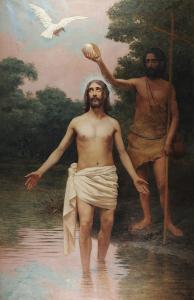
Baptism of Jesus (1895)
Jennie Augusta Brownscombe
(December 10, 1850 – August 5, 1936)
She was an American painter, designer, etcher, commercial artist, and illustrator. Brownscombe studied art for years in the United States and in Paris. She was a founding member, student and teacher at the Art Students League of New York. She made genre paintings, including revolutionary and colonial American history, most notably The First Thanksgiving held at Pilgrim Hall in Plymouth, Massachusetts. She sold the reproduction rights to more than 100 paintings, and images of her work have appeared on prints, calendars and greeting cards. Her works are in many public collections and museums. In 1899 she was described by New York World as “one of America’s best artists.”

Thanksgiving (1914)
Vincent van Gogh,
(March 30, 1853 – July 29, 1890)
He was a Dutch Post-Impressionist painter who is among the most famous and influential figures in the history of Western art.

Roberto Ferruzzi
(December 16, 1853 – February 16, 1934)
He was a Dalmatian Italian artist. He is best known for the painting Madonnina that won the second Venice Biennale in 1897.

Percy French
(May 1, 1854 –January 24, 1920)

He was an Irish songwriter, author, poet, entertainer and painter . Are Ye Right There Michael is one of his songs parodying the state of the West Clare Railway system in rural County Clare.
Albert Gustaf Aristides Edelfelt
(July 21, 1854 – August 18, 1905)
He was a Finnish painter noted for his naturalistic style and Realist approach to art. He lived in the Grand Duchy of Finland and made Finnish culture visible abroad, before Finland gained full independence. He was considered the greatest Finnish artist of the second half of 19th and the first half of the 20th centuries, and one of the most prominent contributors to the Golden Age of Finnish Art.

Boys Playing on the Shore (1884)
Secondo Pia
(September 9, 1855 – September 7, 1941)
He was an Italian lawyer and amateur photographer. He is best known for taking the first photographs of the Shroud of Turin on 28 May 1898 and, when he was developing them, noticing that the photographic negatives showed a positive image of the man in the shroud in addition to a clearer rendition of the image. The image he obtained from the shroud has been approved by the Roman Catholic Church as part of the devotion to the Holy Face of Jesus.

Thomas Benjamin Kennington
(April 7, 1856 – December 10, 1916)
He was a British genre, social realist and portrait painter. He was a founder member of the New English Art Club (NEAC) and the Imperial Arts League.

John Singer Sargent
(January 12, 1856 – April 14, 1925)
He was an American expatriate artist, considered the “leading portrait painter of his generation” for his evocations of Edwardian-era luxury. He created roughly 900 oil paintings and more than 2,000 watercolors, as well as countless sketches and charcoal drawings. His oeuvre documents worldwide travel, from Venice to the Tyrol, Corfu, Spain, the Middle East, Montana, Maine, and Florida.
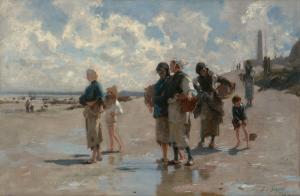
Doane Robinson
(October 19, 1856 – November 27, 1946)
He was an American historian who was the state historian of South Dakota. He is known for conceiving of the idea for the Mount Rushmore National Memorial in the Black Hills, which he believed would stimulate tourism to the area.
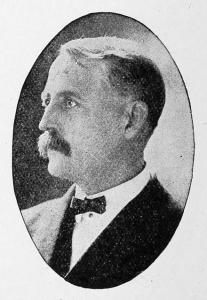
Charles E. Rushmore
(December 2, 1857 – October 31, 1931)
He was an American businessman and attorney for whom Mount Rushmore is named.

Fishing for Oysters at Cançale (1878) National Gallery of Art in Washington, DC
John Russell (Australian painter)
(June 16, 1858 – April 30, 1930)
He was an Australian impressionist painter.

Georges Pierre Seurat
(December 2, 1859 – March 29, 1891)
He was a French post-Impressionist artist. He devised the painting techniques known as chromoluminarism and pointillism and used conté crayon for drawings on paper with a rough surface.
Seurat’s artistic personality combined qualities that are usually thought of as opposed and incompatible: on the one hand, his extreme and delicate sensibility, on the other, a passion for logical abstraction and an almost mathematical precision of mind. His large-scale work A Sunday Afternoon on the Island of La Grande Jatte (1884–1886) altered the direction of modern art by initiating Neo-Impressionism, and is one of the icons of late 19th-century painting.

Bathers at Asnières (1884)
Hans Zatzka – Wikipedia
(March 8, 1859 – December 17, 1945 or 1949)
He was am Austrian Academic and fantasy painter. He signed many of his works as Joseph Bernard, J. Bernard, or Bernard Zatzka. The purpose of Zatzka’s vast array of pseudonyms was to avoid penalties of breaking contracts which limited the amount of artwork he could sell. This has caused some art databases to conflate Zatzka’s work under the pseudonym Joseph Bernard with the French sculptor with the same name.

According to the artist signature on antique postcards, the famous Guardian Angel painting was originally created by H. Zabateri (pseudonym of artist Hans Zatzka.) The Guardian Angel became very famous when art prints were published in the USA under the artist name of Lindberg. No one knows Lindberg’s first name and it seems to be the only painting for which he or she is known. It’s possible that Lindberg was more involved with creating the lithograph templates. I doubt there was an actual painting by Lindberg anywhere. Otto A Stemler did the same thing: he converted many popular black and white engravings & illustrations from the 1800’s and turned them into beautiful full-color lithograph art prints. Stemler’s art prints of the life of Jesus are still very popular today. So I suspect Lindberg’s story is the same. The inspired work of both Stemler and Lindberg are still copied and recreated by modern artists. Guardian Angel
Another Link to the same Picture Guardian Angel 1900
Fridolin Leiber (1853–1912) has drawn a similar image.
Childe Hassam
(October 17, 1859 – August 27, 1935)
He was an American Impressionist painter, noted for his urban and coastal scenes. Along with Mary Cassatt and John Henry Twachtman, Hassam was instrumental in promulgating Impressionism to American collectors, dealers, and museums. He produced over 3,000 paintings, oils, watercolors, etchings, and lithographs over the course of his career, and was an influential American artist of the early 20th century.

Born in 1860’s
Isaac Levitan
(August 30 1860 – August 4, 1900)
He was a Russian classical landscape painter who advanced the genre of the “mood landscape”.

Mary Lizzie Macomber
August 21, 1861 – February 4, 1916)
She was an American artist who painted in the Pre-Raphaelite style.

Edvard Munch
(December 12, 1863 – January 23, 1944)
He was a Norwegian painter. His 1893 work The Scream has become one of Western art’s most acclaimed images.

Harold Copping
(August 25, 1863 – July 1, 1932)
He was a British artist best known as an illustrator of Biblical scenes. His 1910 book The Copping Bible illustrated by himself became a best-seller.

A medical missionary attending to a sick African.
Émile Friant
(April 16, 1863 –June 9, 1932)
He was a French artist and was born in the commune of Dieuze. He would later be forced to flee to Nancy by the encroachment of the Kingdom of Prussia‘s soldiers. He exhibited paintings throughout his lifetime at the Paris Salon.
Friant created works in charcoal, oil, and other media. He also used photographs to prepare finished paintings.

Les Canotiers de la Meurthe (The Meurthe boating party), 1887

Qi Baishi
(January 1, 1864 – September 16, 1957)

He was a Chinese painter, noted for the whimsical, often playful style of his works. Born to a peasant family from Xiangtan, Hunan, Qi taught himself to paint, sparked by the Manual of the Mustard Seed Garden. After he turned 40, he traveled, visiting various scenic spots in China. After 1917 he settled in Beijing. Qi was the master of Hu Jieqing, the wife of Lao She.
The subjects of his paintings include almost everything, commonly animals, scenery, figures, toys, vegetables, and so on. He theorized that “paintings must be something between likeness and unlikeness, much like today’s vulgarians, but not like to cheat popular people”. In his later years, many of his works depict mice, shrimp or birds. He was also good at seal carving and called himself “the rich man of three hundred stone seals. In 1953, he was elected president of the China Artists Association
Forgery and misattribution of Qi’s work has become common in the contemporary art market. He is estimated to have produced between 8,000 and 15,000 distinct works throughout his life, of which 3,000 are in museums. However, since 1993, auction houses have attempted to sell over 18,000 distinct works attributed to him. A painting attributed to him, Eagle Standing on Pine Tree (老鷹圖), was sold for 425.5 million yuan ($65.5 million) in 2011, becoming one of the most expensive paintings ever sold at auction. However, doubts over the painting’s authenticity were later raised by the bidder.
Qi’s first wife was Chen Chunjun. They got married when Qi was twelve years old in his Hunan hometown.] The couple later had five children, three sons: Qi Liangyuan (born 1889), Qi Liangfu (1894-1913) and Qi Liangkun (born 1902) and two daughters (unknown names).

Qi Baishi’s artwork and bibliography
Charles Marion Russell
(March 19, 1864 – October 24, 1926)
Also known as “Kid” Russell, was an American artist of the American Old West.

Valentin Serov
(January 9, 1865 – 5 December 1911)
He was a Russian painter and one of the premier portrait artists of his era.
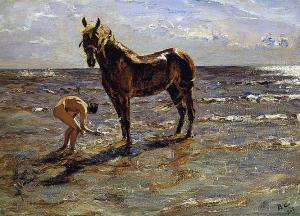
Władysław Podkowiński
February 4, 1866 – January 5, 1895)

He was a Polish master painter and illustrator associated with the Young Poland movement during the Partition period.

Alice Austen
(March 17, 1866 – June 9, 1952)
She was an American photographer working in Staten Island. She is best known for her street photography and her intimate depictions of women’s lives and relationships in the Victorian era.

Gutzon Borglum
(March 25, 1867 – March 6, 1941)
He was an American sculptor best known for his work on Mount Rushmore. He is also associated with various other public works of art across the U.S., including Stone Mountain in Georgia, statues of Union General Philip Sheridan in Washington D.C. and in Chicago, as well as a bust of Abraham Lincoln exhibited in the White House by Theodore Roosevelt and now held in the United States Capitol crypt in Washington, D.C

Max Jakob Friedländer
(July 5, 1867 – October 11, 1958)
He was a German-Jewish museum curator and art historian. He was a specialist in Early Netherlandish painting and the Northern Renaissance, who volunteered at the Kupferstichkabinett Berlin in 1891 under Friedrich Lippmann. On Lippmann’s recommendation, Wilhelm von Bode took him on as his assistant in 1896 for the paintings division. He was appointed deputy director of the Kaiser Friedrich Museum (then containing the Berlin State Museums‘ old master paintings and sculpture) under Bode in 1904 and became director himself from 1924 to 1932, working on his history From Van Eyck to Bruegel and the 14-volume (printed in 16, with supplements) survey Early Netherlandish Painting.

In 1933 he was dismissed as a “non-Aryan” and in 1939 had to move to Amsterdam because he was Jewish.[1] He attained the rank and title of geheimrat (privy councillor) under the German Empire. He also donated several works to the collection and worked in the art trade as an advisor, to convicted war criminal Hermann Göring (January 12, 1893 – October 15, 1946) among others.
During his lifetime he took high quality photographs of artwork wherever he travelled. His personal archive with approximately 15,000 photos and reproductions of 15th- and 16th-century paintings from the North and South Netherlands are often accompanied with notes including such things as the provenance, attribution, relative condition, and location of the paintings. The majority of his work has been transcribed and digitised in the RKDimages database of the Dutch National Institute of Art History (RKD) and forms an important open access archive for art historians

Royal Cortissoz
(February 10, 1869 – October 17, 1948)
He was an American art historian and, from 1891 until his death, the art critic for the New York Herald Tribune. During his tenure at the newspaper, he consistently championed traditionalism and decried modernism. Of the latter, he once wrote, “It will someday prove a kind of Victorian ‘dud’, with a difference, obviously, but a ‘dud’ just the same.”
Cortissoz wrote the inscription engraved above the statue of Abraham Lincoln in the Lincoln Memorial in Washington, D.C.: “In this temple, as in the hearts of the people for whom he saved the Union, the memory of Abraham Lincoln is enshrined forever.”

Born in 1870’s
Howard Chandler Christy
(January 10, 1872 – March 3, 1952)
He was an American artist and illustrator. Famous for the “Christy Girl” – a colorful and illustrious successor to the “Gibson Girl” – Christy is also widely known for his iconic WWI military recruitment and Liberty loan posters, along with his 1940 masterpiece titled, Scene at the Signing of the Constitution of the United States, which is installed along the east stairwell of the United States Capitol.

Salvador Dali’s Parents
Salvador Luca Rafael Aniceto Dalí Cusí (1872–1950)
+ Felipa Domènech Ferrés (1874–1921)
=Salvador Dalí
(May 11, 1904 – January 23, 1989)

He was a Spanish surrealist artist renowned for his technical skill, precise draftsmanship, and the striking and bizarre images in his work.

Walter Friedländer
(March 10, 1873 – September 8, 1966)
He was a German art historian (who should not be confused with Max Jakob Friedländer. Walter wrote the book Caravaggio Studies (1955).

Augusta Curiel
(1873–1937)
She was a Surinamese photographer. She and her sister created an important record of life in the early twentieth century.

John T. Daniels
(July 31, 1873 – January 31, 1948)
He was a member of the U.S. Life-Saving Station in Kill Devil Hills, North Carolina, who took the photograph of the first powered flight on December 17, 1903. The flight was by the Wright brothers flying their Wright Flyer. Daniels, who had never seen a camera before, later said that he was so excited by seeing the Flyer rising that he was unsure if he had squeezed the bulb triggering the shutter. The camera that he operated was a Gundlach Korona V view camera, which used 5-by-7-inch glass-plate negatives. The camera was owned by the Wright brothers, who were careful to record the history-making moment, and also to preserve a record for any future patent claims. The plate was not developed until the Wright Brothers returned to Ohio.

Hugo Simberg
(24 June 1873 – 12 July 1917)
He was a Finnish symbolist painter and graphic artist.

Paul Landowski
(June 1, 1875 – March 31, 1961)
He was a French monument sculptor of Polish descent. His best-known work is Christ the Redeemer in Rio de Janeiro, Brazil.

Christ the Redeemer Sculptor’s Siblings
Dimitrie Leonida
(May 23, 1883–March 14, 1965)
He was a Romanian energy engineer.

Elisa Leonida Zamfirescu
(November 10, 1887 – 25 November 25, 1973)
She was a Romanian engineer who was one of the first women to obtain a degree in engineering. She was born in the Romanian town of Galați but qualified in Berlin. During World War I she managed a hospital in Romania.

Gheorghe Leonida
(1892/93–1942)
He was a Romanian sculptor known for creating the head of Christ the Redeemer, the statue of Jesus Christ in Rio de Janeiro, Brazil.

Eric Enstrom
(1875 – November 16, 1968)
He was a Swedish-born American photographer. Born near Mora, Sweden, he became famous for his 1918 photograph of Charles Wilden in Bovey, Minnesota. The photo is now known as Grace and depicts Wilden saying a prayer over a simple meal. In 2002, “Grace” was designated the state photograph of Minnesota.

Albert Namatjira’s Parents
Namatjirritja Piltharra (abt.1876-1956)
+ Ljukita Mpitjana (abt.1880-1934)
= Albert Namatjira
(July 28, 1902 –August 8, 1959)

He was an Arrernte painter from the MacDonnell Ranges in Central Australia, widely considered one of the most notable Australian artists. As a pioneer of contemporary Indigenous Australian art, he was arguably one of the most famous Indigenous Australians of his generation. He was the first Aboriginal artist to receive popularity from a wide Australian audience.

James Montgomery Flagg
(June 18, 1877 – May 27, 1960)
He was an American artist, comics artist, and illustrator. He worked in media ranging from fine art painting to cartooning, but is best remembered for his political posters, particularly his 1917 poster of Uncle Sam created for United States Army recruitment during World War I.

Boris Kustodiev
(March 7, 1878 – May 28, 1927)
He was a Russian and later Soviet painter and stage designer.

John Hodgson Lobley
(November 28, 1878 – 1954)
He was an English artist and is best known for his work as an official war artist for the Royal Army Medical Corps during World War I.

Born in 1880’s
Franz Marc
(February 8, 1880 – March 4, 1916)
He was a German painter and printmaker, one of the key figures of German Expressionism. He was a founding member of Der Blaue Reiter (The Blue Rider), a journal whose name later became synonymous with the circle of artists collaborating in it.

Vincenzo Peruggia
(October 8, 1881 –October 8, 1925)

He was an Italian museum worker, artist and thief, most famous for stealing the Mona Lisa from the Louvre Museum in Paris on August 21, 1911.

Pablo Ruiz Picasso
(October 25, 1881 – April 8, 1973)

Pablo Picasso was one of the most influential artists of the 20th century.
His first oil painting Picador (1889) was painted by Picasso at the age of eight and he kept it throughout his life. He drew all the time; a great number of sketches dedicated to bullfight (what Spaniard does not like bullfight!) as well as studies of local people’s life remained. Pablo’s father started to involve him in interior decorative painting where he had to paint pigeons’ legs. Then, it was his father who insisted on Pablo’s entering Barcelona Academy of Art. The 13-year old whiz kid accomplished an examination drawing of a naked model for a day while a month was allowed for its creation.

English: The Ladies of Avignon
Georges Braque
(May 13, 1882 – August 31, 1963)
He was a major 20th-century French painter, collagist, draughtsman, printmaker and sculptor. His most notable contributions were in his alliance with Fauvism from 1905, and the role he played in the development of Cubism. Braque’s work between 1908 and 1912 is closely associated with that of his colleague Pablo Picasso. Their respective Cubist works were indistinguishable for many years, yet the quiet nature of Braque was partially eclipsed by the fame and notoriety of Picasso.

John Bauer (illustrator)
(June 4, 1882 – November 20, 1918)

He was a Swedish painter and illustrator. His work is concerned with landscape and mythology, but he also composed portraits. He is best known for his illustrations of early editions of Bland tomtar och troll (Among Gnomes and Trolls), an anthology of Swedish folklore and fairy tales.

Edward Hopper
(July 22, 1882 – May 15, 1967)
He was an American realist painter and printmaker. He is one of America’s most renowned artists and known for his skill in capturing American life and landscapes through his art.

Nighthawks (Hopper) (1942)
Gianni Vella
(May 9, 1885 – September 3, 1977)
He was a Maltese artist. After studying in Rome, he produced many religious works which can be found in many churches in the Maltese Islands, but he also produced some secular works including landscape paintings, cartoons and a stamp design.

Horace Pippin
(February 22, 1888 – July 6, 1946)
He was an American painter who painted a range of themes, including scenes inspired by his service in World War I, landscapes, portraits, and biblical subjects. Some of his best-known works address the U.S.’s history of slavery and racial segregation. He was the first Black artist to be the subject of a monograph, Selden Rodman’s Horace Pippin, A Negro Painter in America (1947), and The New York Times eulogized him as the “most important Negro painter” in American history.

Next Time on
HOARATS
To Understand
What I love and How I Write About History
Hit the Link Above.

To understand about this particular series I’m writing about, please read
The Catholic Bard’s Guide To History Introduction
And to view a historical article click on




